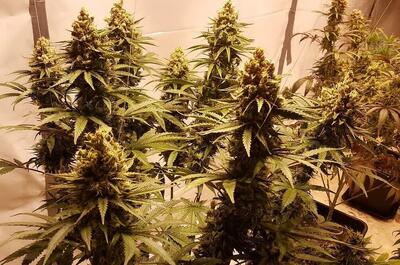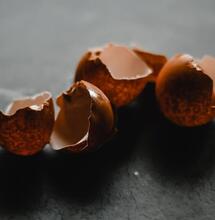How to Perform Monster Cropping?

Monster cropping is a training technique that enables continuous yields without keeping a mother plant. The method helps clones from flowering plants grow into beautiful bushy monsters and give more than a generous harvest. In this article, we explain all you need to know about monster cropping and how to apply this technique to both indoor and outdoor cannabis plants.
Introduction to Monster Cropping: Why Clone a Flowering Plant?
Monster Cropping is an advanced High-Stress Training (HST) technique that revolutionized how cultivators manage their gardens. It’s the practice of taking clones (cuttings) from a cannabis plant already in its flowering phase and forcing those cuttings back into the vegetative state—a process commonly known as re-vegging.
The goal is to eliminate the need for a dedicated mother plant, thereby securing a steady source of your favorite genetics while maximizing space efficiency. This aggressive method causes the plant to enter a survival mode, resulting in highly vigorous, unusually bushy plants with an exceptional amount of lateral branching and potential bud sites.
This concept of manipulating a plant’s growth cycle through stress is fundamental in horticulture, and while Monster Cropping is specific to photoperiod cannabis, the underlying principles of stress training apply across many garden plants to encourage specific growth patterns.
Analyzing the Trade-Offs: Benefits and Drawbacks
Monster Cropping is not a technique for the faint of heart; it requires patience and a high tolerance for risk. Understanding the rewards versus the challenges is crucial before you begin.
The Rewards: What are the Benefits of Monster Cropping?
- Secures Future Yields (No Mother Required): This is the biggest advantage. By cloning a flowering plant, you effectively preserve the genetics and secure future harvests without dedicating space and resources to a non-flowering mother plant.
- Explosive Lateral Growth: Re-vegged clones naturally grow into incredibly dense, “monster” plants. This promotes significant side branching, which translates directly into more colas and a greater number of potential bud sites.
- Increased Yield Potential: The highly branched structure is ideal for maximizing light exposure and is perfectly set up for integration with other techniques, such as the Screen of Green (ScrOG).
The Challenges: Drawbacks to Consider
- Strain Limitations: This technique only works with photoperiod cannabis strains. Do not attempt Monster Cropping on autoflowers or naturally short/slow-growing cultivars, as they lack the hormonal mechanism needed for successful re-vegging.
- Lower Success Rate: Expect a notable failure rate when cloning. Not all cuttings taken from a flowering plant will successfully root and re-veg. A good rule of thumb is to take at least 20% more cuttings than you actually need, anticipating that some will simply fail to develop roots.
- Extended Timeline: The re-vegetation phase adds anywhere from two to four weeks to your overall cultivation cycle. If you are in a hurry to harvest, this method will postpone your timeline.

Step-by-Step Guide to Monster Cropping Indoor Cannabis Plants
Indoor environments offer the best control for a complex cannabis training technique such as Monster Cropping. Follow the instructions below for the highest chance of success:
Phase 1: Selecting and Taking the Cuttings
- Selection Timing: Look around your grow room during the second week of flowering. This timing provides the optimal balance of growth hormones for rooting. Select only the sturdiest, healthiest plants for cloning.
- The Cut: Use a pair of scissors or a knife that has been thoroughly sterilized with alcohol. Select a cutting from a lower branch and ensure the cut is made diagonally across the stem. This diagonal cut maximizes the surface area for water and nutrient uptake.
- Immediate Care: Immediately submerge the cutting in a water-filled container to prevent air from entering the stem, which can cause the cutting to die quickly.
Phase 2: Rooting and Re-Vegging
- Root Stimulation: Dip the cut end of the clone into a quality rooting gel or powder to stimulate root growth.
- Rooting Medium: Place the cutting into your chosen medium, such as rockwool cubes, perlite, or a light coco/perlite mix.
- Light Cycle Switch: To force the clone back to vegetative growth, you must switch the light schedule back to a minimum of 18 hours of light and 6 hours of darkness (18/6), or even a continuous 24/0 light cycle.
- Identifying Re-Veg: The cutting will eventually begin to grow in a strange, non-traditional manner, exhibiting single-pointed, rounded leaves and a sudden surge of many tiny branches. This phase confirms the hormonal transition and typically concludes within a month as the plant resumes normal, vigorous vegetative growth.
Advanced Strategy: Integrating ScrOG with Monster Crops
The inherent bushiness and lateral focus created by Monster Cropping makes it the perfect precursor to the Screen of Green (ScrOG) technique.
- Pruning for Structure: Let the re-vegged cuttings veg into large, dense bushes. Before the final flip to flower, you can use repeated topping (removing the main growth tip) to stimulate even more lateral growth. Remember that each topping session will add approximately one week to your waiting time, but the payoff is substantial.
- The ScrOG Advantage: Once the plant is established, install your ScrOG net. Weave the abundant side branches through the mesh. The combination of Monster Cropping’s extreme branching and ScrOG’s uniform light distribution creates a flat, even canopy where every single bud location receives maximum light exposure, resulting in massive, heavy colas.
Monster Cropping Cannabis Outdoors: Location is Key
While primarily an indoor technique, Monster Cropping can be applied to outdoor cannabis cultivation, provided you are in the correct climate.
- Climate Restriction: The technique will only succeed in warm regions with long, frost-free seasons (e.g., the Southern US). In northern climates, attempting this would likely result in the death of your young plants.
- Optimizing the Season: For outdoor growers, if you plant seeds during the winter (when nights are long), the plants may enter flowering quickly. To use Monster Cropping effectively, you can interrupt the long dark cycle using artificial light during the night to artificially extend the vegetative phase. This helps the re-vegged clones gain critical mass.
- The Double Harvest Window: By managing the light cycle, you can time your first harvest for early spring. The resulting re-vegged clones will then naturally gain mass during the long days of summer and progress into a second, natural flowering phase as the days shorten, leading to a massive second harvest in the fall season.
Read more from Soft Secrets:
- 10 Ways To Grow The Biggest Cannabis Yields
- Training Outdoor Cannabis Plants for Bigger Yields
- A Beginner’s Guide to Hydroponics
Last updated November 24, 2025















